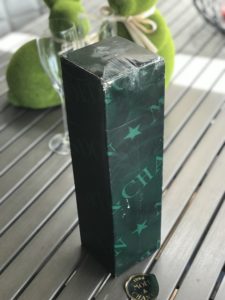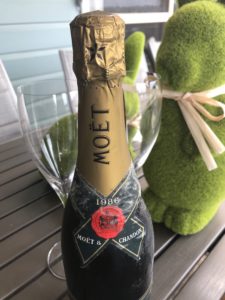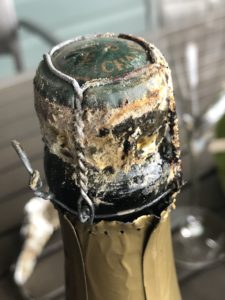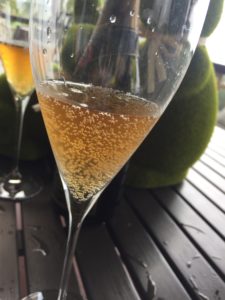I recently wrote about the joy and anticipation of being offered a bottle of 1986 Moet et Chandon that had been long forgotten under the stairs of a Queensland suburban home. Would magic emerge from under the stairs?
Since this whole exercise was about appreciating what is actually in the glass we are drinking, I had to wait until a day when I was unhurried and could fully appreciate what was going on. That day turned out to be Easter Saturday, a lazy day at home that started with a big garden clear out and ended rather more thrillingly.
I think there was quite a bit of poetic justice opening the bottle at Easter. Not that I am terribly religious, but I did have the feeling that this magic bottle was some sort of holy grail I was holding in my hands.
So there is was, this box, wrapped in plastic, that had been forgotten under the stairs for more than 20 years. Rather like writing this post, I didn’t really know where to start. The problem was the anticipation had built up so much, it was almost more fun thinking about what it might be, rather than knowing what it was. And once it was opened, there was no going back. What ever happened from the point of unwrapping that plastic, my heart was either going to sink or sing. And if it sank, then a little bit of the magic of champagne I believe in so much would sink with it.
Unwrapping the plastic

The bottle once the plastic wrap was removed
I could only keep looking at the box for so long, though, my drinking buddy was starting to get impatient!
After unwrapping the plastic, my senses were almost assaulted by a strong musty smell that was only compounded when I opened the box. It reminded me enormously of the smell that you are hit with as you step deep down into the very cellars of Champagne themselves. A deep earthy, musty, damp combination, that to me didn’t seem promising given the circumstances. It made me think that perhaps the alcohol had escaped from the bottle and the remaining contents had stagnated. If the cork had completely dried up, the contents could have gradually seeped out through the foil. My heart sank just a little.
Removing the bottle

The mildew covered bottle
Taking the bottle out of the box didn’t do much to lighten the situation. The bottle was covered in mildew – which would have been normal had we pulled it out of a chalk cellar 30m underground. But as previously documented, that was not where this bottle came from. Even more disappointing, when I held it up to the light, I could see considerable ullage (the pocket of air between the cork and the wine). The air space was visible just under the level of the foil. Normally there is about 1 cm of space between the cork and wine. This was about 3 or 4cm.
The problem with this is the oxygen that fills the airspace. A little oxygen is beneficial to the ageing process, but too much can result in flaws. The level did nothing to assuage my fears that the cork had dried out and the champagne leaked. Additionally, there seemed to be some sediment floating around in the bottle.
Removing the foil

The rather unsavoury looking cork
The was no turning back – the bottle needed to be opened. Removing the foil didn’t help either. The bottle looked like it had been pulled out from the bottom of the ocean. The cap was crusted to the cork and the cage so rusted it looked like it would break on touch. At this point my husband had completely given up. He shrugged his shoulders in that very French way and said ‘Boof, we’ll open it but I will go and find something else!’. ‘Wait,’ I said, ever the optimist. ‘Let me just video you opening it – you never know, there may just be a pop.’ Withering does not even begin to explain the look directed at me. So he patiently allowed me to video the ‘Grand Opening of the Champagne from Under the Stairs’.
The Grand Opening of the Champagne from Under the Stairs
Well guess what? There was a distinct pop! There was gas in the bottle! There is magic after all! My heart started to sing. Just a little.
Tasting the magic
The final test was still in the taste. It should be said that there were still a lot of things that could have been wrong with the champagne, despite the fact that there was gas in the bottle. But I was convinced that it was all going to be amazing from this point on.
The champagne itself was a lovely deep, rich golden colour. The bubbles were super fine, but they were present and they were rising in a lazy endless stream, sleepily bursting on the surface as they were woken up from their 32 year slumber.
The aromas wafting up were Cognac in character. As rich as the colour and as gentle as the sleepy bubbles. As would be expected with a champagne this age, there were layers of complexity. Brioche, and gingerbread, mushrooms and honey. Even a hint of chocolate.
And that first sip? It was sublime. We sat on that glass for quite some time. Mindful of what was happening to our senses. Mindful of what went into making that champagne. Mindful of the incredible journey it had been on to make its way to our glasses – from little grapes coming off vines that had experienced a beautiful growing season only to be ravaged by too much rain in August and September, to lying untouched under the stairs.
Mostly I was just grateful that I was able to enjoy this experience and to see once more that there really is a little bit of magic in champagne. My heart was singing.

